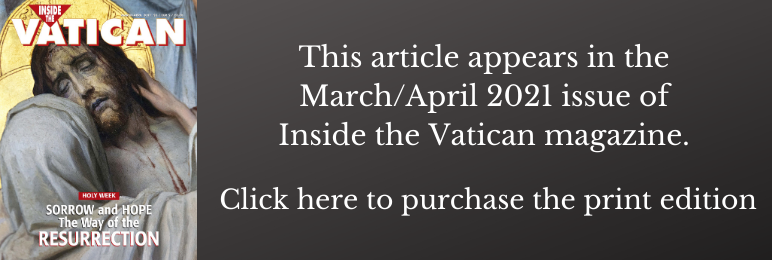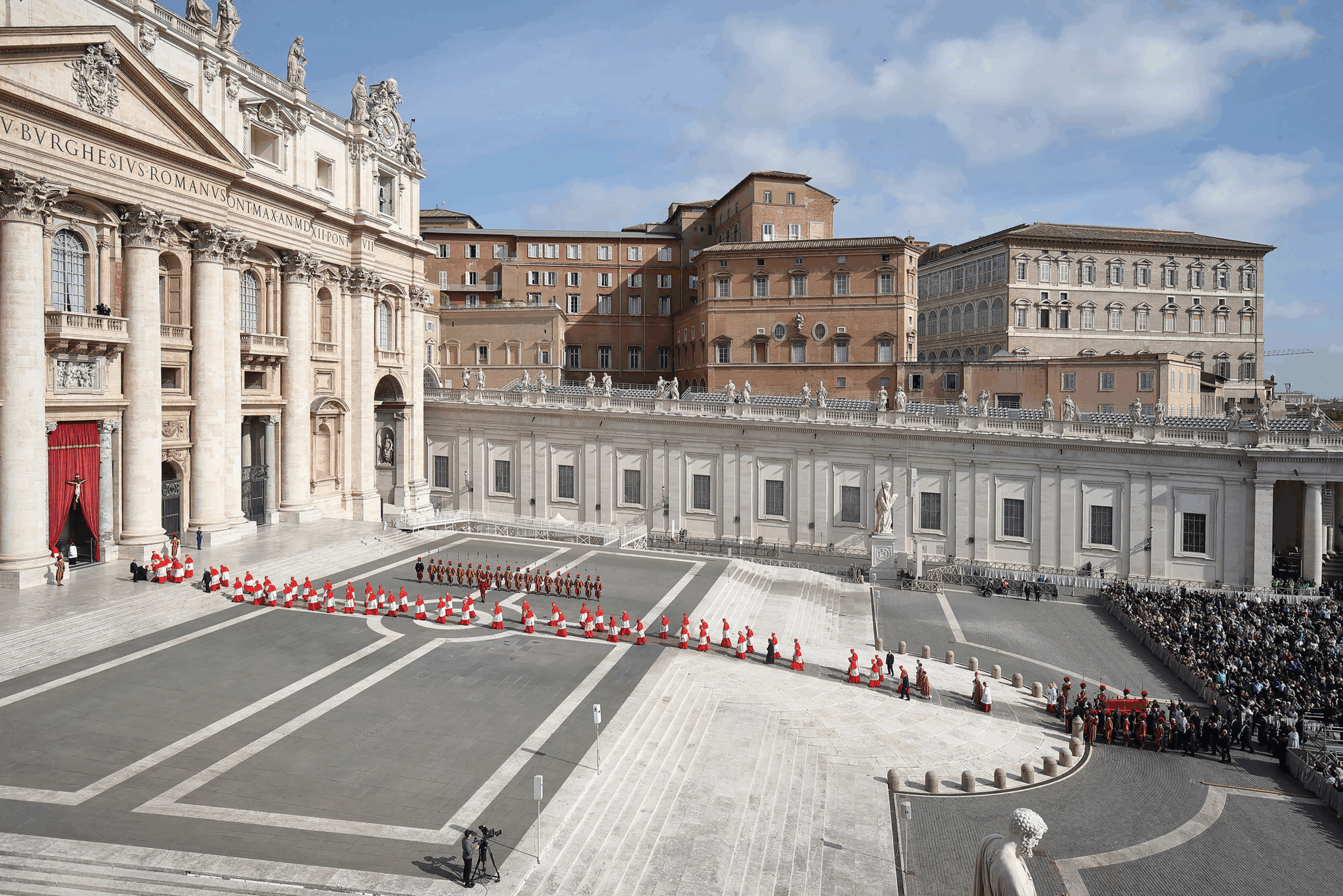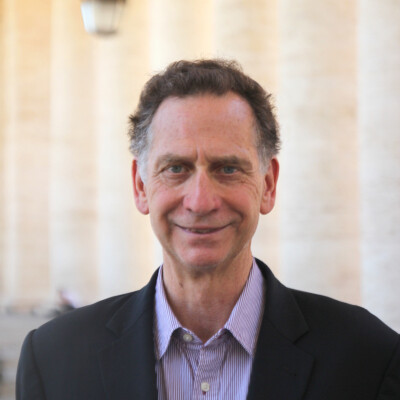The story of one man’s devotion over a lifetime of changes in the Church. A tribute to an Italian priest who died on February 26, 2021: Monsignor Giovanni Braschi. May eternal light shine upon him
By Robert Moynihan
February 28, Feast of St. Hilary (Pope 461-468 A.D.)
I received sad news on Friday, February 26, from a shrine in southern Italy, not far from Naples, dedicated to St. Philomena.
“It is great sadness we make this announcement,” Sister Paz and Sister Marichu wrote to me in an email. “Monsignor Giovanni Braschi (October 24, 1943-February 26, 2021), Rector of the Sanctuary of St. Philomena, Custodian of the Sacred Body of St. Philomena, President and Spiritual Director of the Universal Archconfraternity of St. Philomena, passed away suddenly this morning at 10:30 in the Sanctuary of St. Philomena in the presence of loved ones. He was suffering from bronchitis over the past week which had worsened in the past 24 hours. Today Our Lord called him home when his heart stopped… He was the worldwide expert on everything related to St. Philomena and was definitely the greatest devotee of St. Philomena our time has known. He is now in the presence of St. Philomena and is at peace. He leaves behind his older sister Antoniette who he spent every lunch and evening meal with, he loved her dearly and cherished this time with her. He loved his nieces and nephews and spoke affectionately of them, he always prayed for them. His family life was dear to him and they all took turns at helping him with his work in the sanctuary throughout the years.”
I had come to known Monsignor Braschi in early 2013, when I brought a group of about 25 pilgrims to Mugnano del Cardinale, near Avellino, Italy. (It was in the days just before Pope Benedict XVI resigned his papacy, on February 11, 2013.)
Braschi was delighted to see us, overjoyed, I would say, at the interest shown by our pilgrims in St. Philomena. Why overjoyed? Because, in 1961, on the advice of some historians, the Vatican decided to suppress the Feast of St. Philomena — to treat her as a saint who was not historically verifiable, a pious legend, not an actual, living, suffering, loving saint. Braschi thought that decision was a terrible mistake.
“St. Philomena certainly lived,” Braschi said to me and my pilgrims. “She was a young woman who was martyred for her faith, and she is one of the most powerful intercessors for those who pray to her. So many prayers answered, so many miracles performed, all attest to her actual existence!”
I can still remember the radiance of his joyful face as, with a large key which he drew from under his cassock, he opened the lid containing what he believed were three authentic tablets from St. Philomena’s grave. He lifted them up, then handed one of them to me to hold. “Here is the inscription, see,” he said to me, with great animation. “Here, you can read the words, written on three tablets, found on May 25 in 1802 in the Catacombs of Priscilla in the north of Rome. The letters say: ‘LUMENA / PAXTE / CUM FI.’ But that is not the right order. In the correct order, the tablets read ‘PAX TE / CUM FI / LUMENA’ — ‘Peace (Pax) be with you (tecum), Philomena (Filumena).’” Also inscribed on the tablets were symbols: a lily, arrows, an anchor and a lance, which would appear to indicate virginity and martyrdom. Inside the coffin were discovered the remains of a girl of about 12 or 13 years of age, along with a vial or ampulla of her dried blood. So it seems there was a devotion to a young girl who was treated by the early Christians of Rome as a virgin and martyr, and whose name may have been Philomena.
Then Braschi actually handed one of the tablets to me, telling me to lift it, to see it was real, substantial, heavy, proof of the existence of St. Philomena. “Lift the tablet?” I asked, hardly believing he was serious. “Yes, lift it, lift it,” he said.
And I lifted up the tablet. I still have a memory of how that tomb tablet, apparently from the first centuries of the Christian era, perhaps from the 100s or 200s, so, more than 1,800 years ago, felt in my hands: real, substantial, profoundly moving…
The nuns wrote: “It wasn’t an easy job he took on, restoring the Sanctuary and reviving the devotion to St. Philomena. He loved history and he researched everything about St. Philomena and with this, facts and science, he set about restoring the devotion to St. Philomena. ‘This devotion had not gone away, it was only suppressed,’ he would say… He was a kind and loving man who completely dedicated his life to St. Philomena. But if you did something against St. Philomena or the Sanctuary, he let you know! It’s fair to say he was passionate about this.”
“Braschi was born in Mugnano del Cardinale, on October 24, 1943, so he grew up during the realm of the grandest feast celebrations of St. Philomena within Mugnano. This was a time when people flocked to the Sanctuary during the August feast (August 11). There was a solemn Mass and prayers within the church and great festivities outside, all one would expect on a very grand Italian occasion for this very important and special person… Throughout Msgr. Braschi’s training in the seminary he would go to the Sanctuary and pray at the Sacred Altar of St. Philomena to help him to get through the studies and pass his exams to become a priest. These exams were quite tough, and he promised St. Philomena that if she could help him through he would offer his priesthood to her.”
And so it was. This man, whose boyhood was shaped by the great feasts in honor of Philomena, dedicated his priesthood to Philomena. In 1983, Bishop Giuseppe Costanzo of Nola named him Rector of the Sanctuary, and he stayed at his post until the end. In November 2016 he suffered a major heart attack. It required surgery and his feet became badly infected. He was advised the solution was a bilateral amputation above the knee, but he refused. Today is a sad day at the Sanctuary, and no words can describe the sorrow of his passing. St. Philomena, the martyr of chastity and faith in Christ, can halt the spread of materialism and cold rationalism of today, through a spirit of ardent faith.







Facebook Comments